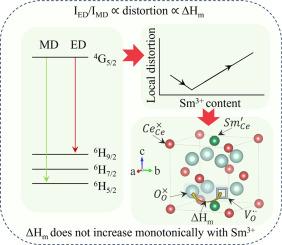Revealing the concentration quenching mechanism of oxygen ion conduction in Sm3+-doped CeO2 via photoluminescence
IF 5.7
3区 材料科学
Q2 MATERIALS SCIENCE, MULTIDISCIPLINARY
引用次数: 0
Abstract
Probing local lattice distortions in acceptor-doped CeO2 oxygen ion conductors is important to understanding ionic conduction mechanism and improving performance. Dense Ce1-xSmxO2-δ (SDC) oxygen ion conductors were synthesized. AC impedance shows that x = 0.10 yields the highest bulk conductivity (8 mS/cm at 500 °C), surpassing reported values. Raman results indicate a monotonic increase in defect association between oxygen vacancies and Sm3+ with doping. We propose a spectral probe strategy using Sm3+ photoluminescence to detect local lattice distortions in SDC. Photoluminescence shows local lattice distortion decreases then increases with Sm3+ content, with x = 0.05 lowest, explaining the activation energy of bulk conduction trend, then revealing the structural origin of bulk conductivity quenching. Furthermore, photoluminescence analysis shows that higher Sm3+ levels also increase disorder around Ce4+ and Sm3+. This photoluminescence strategy offers a sensitive tool for probing local lattice distortions and can be extended to other materials with Sm3+-doping available.

通过光致发光揭示Sm3+掺杂CeO2中氧离子传导的浓度猝灭机制
探测受体掺杂CeO2氧离子导体的局部晶格畸变对理解离子传导机理和提高导体性能具有重要意义。合成了致密的Ce1-xSmxO2-δ (SDC)氧离子导体。交流阻抗显示,x = 0.10产生最高的体积电导率(500°C时为8 mS/cm),超过了报道的值。拉曼结果表明,掺杂后氧空位与Sm3+之间的缺陷关联单调增加。我们提出了一种利用Sm3+光致发光的光谱探针策略来检测SDC中的局部晶格畸变。光致发光显示,局部晶格畸变随Sm3+含量的增加先减小后增大,其中x = 0.05最低,解释了体导趋势的活化能,揭示了体导猝灭的结构根源。此外,光致发光分析表明,较高的Sm3+水平也增加了Ce4+和Sm3+周围的无序性。这种光致发光策略为探测局部晶格畸变提供了一种灵敏的工具,并且可以扩展到Sm3+掺杂的其他材料中。
本文章由计算机程序翻译,如有差异,请以英文原文为准。
求助全文
约1分钟内获得全文
求助全文
来源期刊

Materials Research Bulletin
工程技术-材料科学:综合
CiteScore
9.80
自引率
5.60%
发文量
372
审稿时长
42 days
期刊介绍:
Materials Research Bulletin is an international journal reporting high-impact research on processing-structure-property relationships in functional materials and nanomaterials with interesting electronic, magnetic, optical, thermal, mechanical or catalytic properties. Papers purely on thermodynamics or theoretical calculations (e.g., density functional theory) do not fall within the scope of the journal unless they also demonstrate a clear link to physical properties. Topics covered include functional materials (e.g., dielectrics, pyroelectrics, piezoelectrics, ferroelectrics, relaxors, thermoelectrics, etc.); electrochemistry and solid-state ionics (e.g., photovoltaics, batteries, sensors, and fuel cells); nanomaterials, graphene, and nanocomposites; luminescence and photocatalysis; crystal-structure and defect-structure analysis; novel electronics; non-crystalline solids; flexible electronics; protein-material interactions; and polymeric ion-exchange membranes.
 求助内容:
求助内容: 应助结果提醒方式:
应助结果提醒方式:


